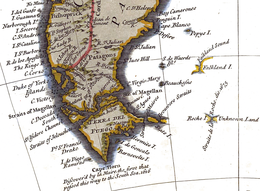Pepys Island
|
Pepys Island in detail (William Hacke, 1699, Collection of Original Voyages)
|
|
| Pepys Island depicted on an 18th century map (R.W. Seale, ca. 1745, fragment) | |
| Geography | |
|---|---|
| Administration |
Pepys Island /ˈpiːps/ is a phantom island, once said to lie about 230 nautical miles (260 mi; 430 km) north of the Falkland Islands at 47°S. Pepys Island is now believed to have been a misidentified account of the Falkland Islands.
In December 1683 the British corsair William Ambrose Cowle(y), master of the Bachelor's Delight, a ship of 40 guns proceeding on a circumnavigation of the globe, discovered at a latitude stated as 47°S a previously uncharted and unpopulated island in the South Atlantic which he named "Pepys Island", for Samuel Pepys, Secretary to the Admiralty. His companion on the voyage, William Dampier, considered the sighting to be the "Sebaldinas Islands", an alternative name at the time for the Falklands. Cowle's log entry reads:
There is a later manuscript elaborating the log entry:
The original official historian of record, Pedro de Angelis, wrote in 1839 that this was so far north of the Falklands it was "absurd" to think that an experienced navigator could have made such an error as to put himself four degrees of latitude more northerly, and in high summer. Many expeditions attempted unsuccessfully to locate the island during the eighteenth century. These included: Lord Anson (1740–1744 voyage), Commodore Byron (1764), Captain Cook (both voyages), Banks and Solander (1769), Pernetty (1763–1764), Bougainville (176–1769 voyages), Pérouse (1785, searching for "The Great Island") and Vancouvert (1790–1795 voyages, also searching for "The Great Island"). In the reports of Byron, Cook and Bougainville all found themselves in thick sargasso with large flocks of birds overhead. They were searching 80 to 85 leagues both east of the Patagonian coast and north of the Falklands (from 1630–1840 a Spanish league measured three nautical miles) and these may be considered sure signs of the proximity of land. La Pérouse mentioned the seaweed and identified the flocks of birds as albatross and petrels which never approach land except to lay their eggs.
...
Wikipedia

